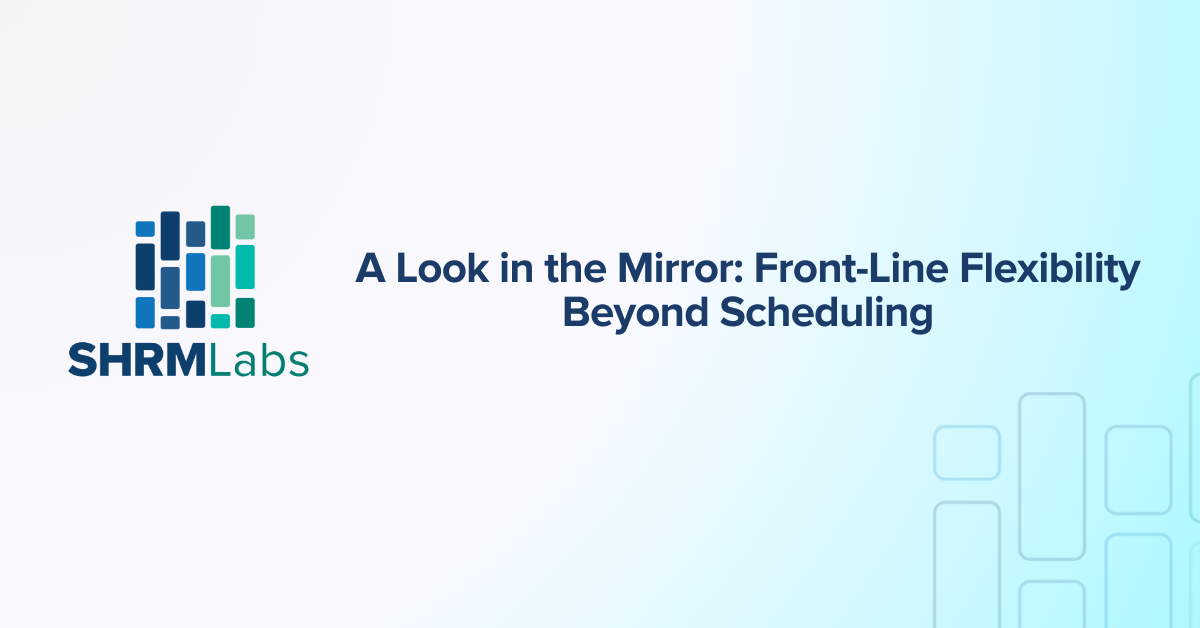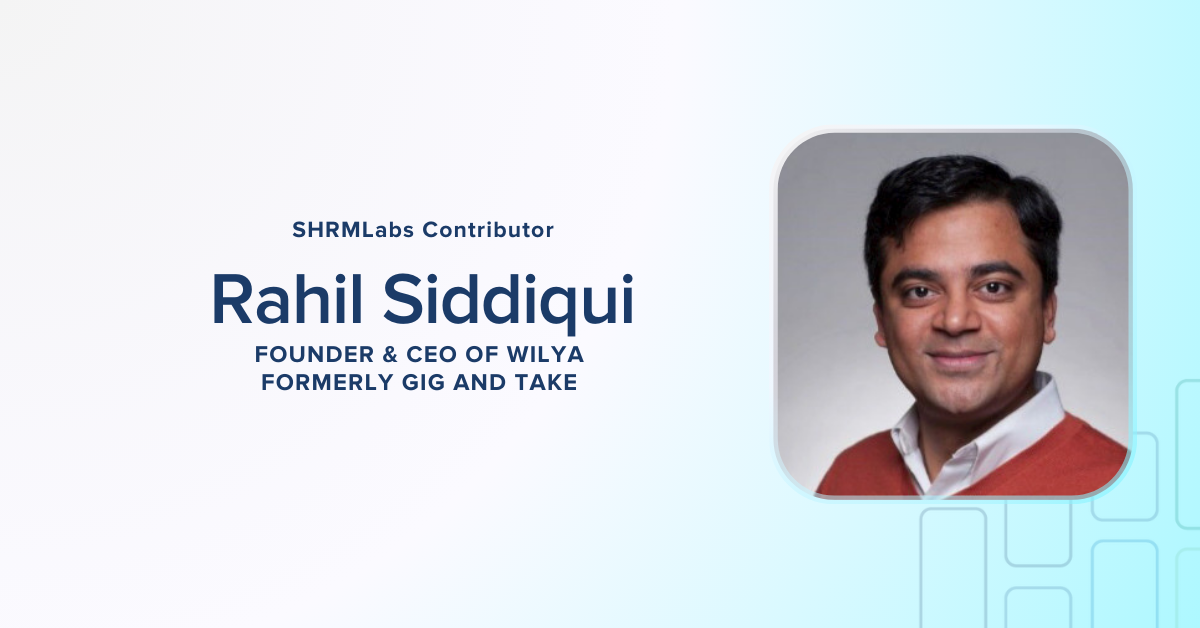A Look in the Mirror:
Front-Line Flexibility Beyond Scheduling

Before we begin…
Welcome to the WorkplaceTech Pulse, presented by SHRMLabs. We are expanding our resources to bring you the best possible information from leaders in HR technology and transformation.
My name is Nell Hellem, innovation catalyst at SHRMLabs. You will hear from me as well as my colleagues every other week with the release of each new edition. Let us know any topics you’d like to hear about related to workplace tech and we will consider them for future editions of the WorkplaceTech Pulse.
Introduction
In an era of rapid change and evolving workforce dynamics, the manufacturing sector faces unprecedented challenges and opportunities. Can you envision a reality in which concerns about hourly worker turnover or an impending wave of retirements vanish? The manufacturing labor market is in flux, experiencing a resurgence in the U.S. alongside a looming shortage of skilled workers as Deloitte predicted that millions of manufacturing jobs could remain unfilled by 2030. However, amid these shifts, many organizations grapple with the adoption of a skills-based approach in their talent strategies, hindering effective workforce planning. As workers increasingly prioritize flexibility over traditional perks, the emergence of the gig economy further underscores the need for factories to reimagine their approach to workforce management. In this landscape, flexibility isn’t just a buzzword, it’s a strategic necessity that extends beyond conventional scheduling. This article explores key aspects of flexible work in factories, highlighting the need for organizations to assess their readiness to adapt and thrive in the face of unprecedented change.
I’m excited to introduce this edition’s contributor, Rahil Siddiqui, founder of Wilya. Rahil, over to you!

Thanks, Nell! I’m Rahil Siddiqui, founder and CEO of Wilya, formerly known as Gig and Take. Wilya is a software solutions provider that enables skills-based, flexible work options for supply chain operations and the factory floor. We work with customers to fully unleash existing talent and unlock new part-time, on-demand talent pools in their communities. Our customers are able to reduce labor costs and get the right worker with the right skills to the right place at the right time.
My background is in global manufacturing HR leadership, where I’ve held a variety of roles such as HR Business Partner, factory operations, human resource information system, and mergers and acquisitions at Fortune 500 companies including TE Connectivity and GE. I earned my master’s in industrial and labor relations from Cornell University.
Before founding Wilya, I served as an HR Business Partner to the Chief Supply Chain Officer of a $14 billion manufacturing company. An article in CNN about the Great Resignation was the catalyst for Wilya’s inception. The company was founded on the basic principle that, with the right tools, manufacturing companies can provide greater flexibility to their factories and not only retain, but also attract, new talent to the industry. We’re here to co-create the future of work.
Be sure to check out all of our editions of the WorkplaceTech Pulse!
Can you imagine …
- Not being concerned about hourly worker turnover in your factory?
- Not being worried about a workforce slated to retire within the next five to 10 years?
- If so many hourly workers were cross-trained to work in multiple areas that supervisors could easily “plug and play” workers to optimize operations?
The manufacturing labor market is changing rapidly amid a resurgence of manufacturing in the U.S. However, this shift is accompanied by challenges such as the retirement of skilled workers. Deloitte predicted that 2.1 million manufacturing jobs could go unfilled by 2030. Despite these trends, many organizations are struggling to adopt a skills-based approach in their talent strategy, hindering effective workforce planning.
Increasingly, workers are prioritizing flexibility over higher pay and benefits, contributing to a migration toward the gig economy. Nontraditional employers such as Uber, DoorDash, and Instacart are attracting talent away from traditional manufacturing roles. The shift emphasizes the need for factories to rethink their approach to workforce management.
In manufacturing, flexibility is not just a buzzword, it is a strategic necessity that goes beyond traditional scheduling. To remain competitive, factories must assess their readiness to create pathways to tomorrow’s jobs.
Key Aspects of Flexible Work in Factories
Flexibility can still be offered regarding when, how much, and even what kind of work a front-line worker can do.
- When front-line workers work means that workers can adjust their work hours to suit their needs better. This may sound too good to be true, but options can include offering flexible hours or compressed workweeks or accommodating personal commitments.
- How much front-line workers work is about balance. Balancing workload is an integral part of flexibility. At some organizations, workers can adjust their workload based on capacity, life circumstances, or personal preferences. This can include options for shorter shifts, job sharing, preferred workdays based on availability, or variable hours based on individual needs.
- What front-line workers work on extends to the type of tasks and projects workers engage in. It is about enabling workers to have a say in their work, allowing them to explore different skills and aligning tasks with their interests and career paths.
Through dozens of interviews, focus groups, and client testimonials, we have identified four levels of progressing maturity based on the following prerequisites to flexible work:
- Labor composition. A mix of full-time, part-time, contract/temporary, and flexible workers.
- Skills inventory. Inclusion of skills-based career pathing and cross-skilling.
- Inclusive policies. Processes and policies that include hourly workers and leadership teams across departments are bought in and aligned to the value of providing flexibility.
- Technology integration. Enabling flexibility through intuitive, real-time, and scalable technology solutions.
Benefits of Labor Flexibility
The findings are clear: The more labor flexibility there is for front-line workers, combined with an organization that is further along on its own maturity journey, the greater the benefits. Organizations at the highest levels have made a strategic investment in flexibility for front-line workers, and they are thriving. These organizations see better business outcomes, including increased efficiency and worker productivity. Their labor costs have reduced as they see less spend on overtime, agency, and turnover. Thriving organizations see an increase in gender diversity and overall stronger employee engagement.
Leveraging a Factory Flexibility Maturity Assessment
Wilya’s factory flexibility maturity model helps operations and HR leaders assess their organizations’ maturity in terms of flexible labor and provides suggestions for improving organizational capabilities. Traditional maturity models may focus on isolated aspects of flexible labor, but our model adopts a comprehensive approach.
Every factory is unique. This structured framework helps evaluate processes and identify strengths and weaknesses. With organizational maturity, cause and effect can be challenging, and action plans are not one-size-fits-all. Many factors can influence your results, and the assessment will help guide strategic decision-making. Identify priority areas for development and create a road map for enhancing maturity over time. Maturity is not a static state but a continuous journey.
Embrace the Future of Flexible Labor
As we enter a new era of workforce flexibility, organizations must seize the opportunity, foster innovation, and adapt to the evolving workforce. Start with small, intentional changes to stay ahead of the curve. Visit the Flex Maturity Assessment to assess your factory’s flexibility maturity and embark on a transformative journey.
The future of work is here—embrace it.
References and Further Reading
Thanks for joining us for this edition of the SHRMLabs WorkplaceTech Pulse and to Rahil for his incredible insights on front-line worker flexibility. Please visit Wilya’s website to learn more about the work they are doing or feel free to email them if you have any questions about this assessment. We will see you next time!

Wilya is a software solutions provider that enables skills-based, flexible work options for supply chain operations and the factory floor. Wilya customers are able to reduce labor costs and get the right worker with the right skills to the right place at the right time. Wilya works with customers to fully unleash existing talent and unlock new part-time, on-demand talent pools in their communities. Founded in 2021, Wilya’s easy-to-use, intuitive solution is purpose-built by a team of experts with decades of experience in manufacturing, supply chain, operations, human resource information systems, mergers and acquisitions, and HR. To learn more about Wilya, visit Wilya.com.

SHRMLabs, powered by SHRM, is inspiring innovation to create better workplace technologies that solve today’s most pressing workplace challenges. We are SHRM’s workplace innovation and venture capital arm. We are Leaders, Innovators, Strategic Partners, and Investors that create better workplaces and solve challenges related to the future of work. We put the power of SHRM behind the next generation of workplace technology.


